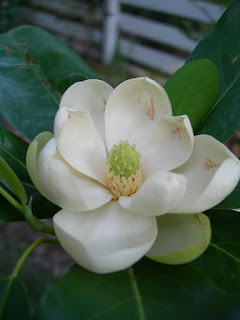 floral fragrance. To have a sweet bay magnolia next to your patio, in flower, on a soft warm evening, to accompany your mint julep, served by an attractive woman in a white dress, with some Dixieland jazz in the background, is almost too much to ask for. The Phactor is not greedy and will settle for any 4 out of the five.
floral fragrance. To have a sweet bay magnolia next to your patio, in flower, on a soft warm evening, to accompany your mint julep, served by an attractive woman in a white dress, with some Dixieland jazz in the background, is almost too much to ask for. The Phactor is not greedy and will settle for any 4 out of the five.The flowers open around 5 pm, rather quickly, and attract beetles with their fragrance all evening. Somewhat surprisingly, this southeastern, mostly coastal species, Magnolia virginiana, will grow here in Lincolnland as far north as zone five. My present specimen survived -19F this past winter and still flowered! A previous specimen was not so hardy, so always check the nursery source of the stock to make certain you get a hardy genotype, if that may be a problem. Up here in Lincolnland sweet bay magnolia mostly grows as a large shrub; in its native range it’s a tree.
Magnolia is an honorific for Pierre Magnol, a professor of botany at Montpellier in the late 1600s and early 1700s, and he must have been well liked by Linnaeus (aka Carl von Linné) to have had such handsome plants named after him.
Long-time readers may detect a certain pattern in the know-your- genera lessons. You already know lots of scientific names, even if you were not aware you did.



















